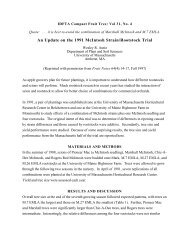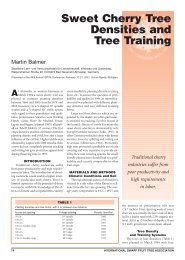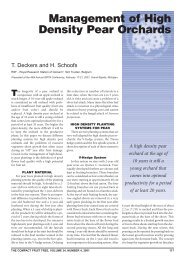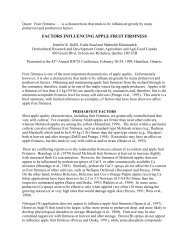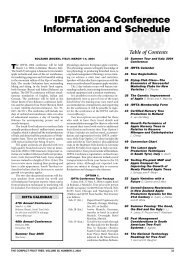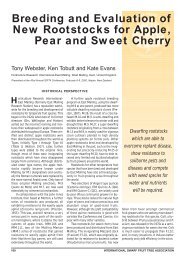Management of High Density Orchards - Virtual Orchard
Management of High Density Orchards - Virtual Orchard
Management of High Density Orchards - Virtual Orchard
You also want an ePaper? Increase the reach of your titles
YUMPU automatically turns print PDFs into web optimized ePapers that Google loves.
constant is the make up <strong>of</strong> variable and<br />
fixed costs. We have found that in the Lake<br />
Chelan area <strong>of</strong> Washington State most<br />
farms are small, averaging about 40 acres.<br />
We found that the fixed costs <strong>of</strong> the<br />
business are about $3000 per acre. We<br />
FIGURE 2<br />
added $25 ($1 per bushel per bin) in variable<br />
costs for each bin. We charged each<br />
system 10% annual interest on the establishment<br />
and production investments.<br />
NOTE: The interest for establishment<br />
costs for the first three seasons and the<br />
Relationship <strong>of</strong> four systems with varying tree density and fruit production during four seasons.<br />
Production (boxes/acre)<br />
5000<br />
4500<br />
4000<br />
3500<br />
3000<br />
2500<br />
2000<br />
1500<br />
1000<br />
500<br />
0<br />
11' x 2', V-trellis<br />
11' x 3.25', Vertical Axis<br />
12' x 4.5', Vertical Axis<br />
13' x 6.5', Vertical Axis<br />
1994 1995 1996 1997 Total<br />
FIGURE 3<br />
Per box cost <strong>of</strong> production during four seasons was directly tied to production level.<br />
Cost/box<br />
$16.00<br />
$14.00<br />
$12.00<br />
$10.00<br />
$8.00<br />
$6.00<br />
$4.00<br />
$2.00<br />
$0.00<br />
1994<br />
1995<br />
1996<br />
1997<br />
11' x 2' 11' x 3.25' 12' x 4.5' 13' x 6.5'<br />
V-trellis<br />
Vertical Axis<br />
production interest for the 1994 crop were<br />
“capitalized” and added to the investment<br />
cost. There was no overhead charged for<br />
the first two seasons, as costs were very<br />
nominal such as mowing, irrigation and<br />
herbicides were less than $100 per acre per<br />
year and were the same for each system.<br />
The training costs were $1 per tree. No<br />
pruning was done until third season. We<br />
did not place an opportunity cost on the<br />
land because it was the same for all systems.<br />
We used a return <strong>of</strong> $250 per bin<br />
(FOB <strong>of</strong> $20 per packed box) to the orchard<br />
as a revenue constant. An FOB decline<br />
<strong>of</strong> $5 would cut the per bin return to<br />
$125 per bin. Due to the stiff interest rates<br />
and overhead costs, none <strong>of</strong> the systems<br />
would pay <strong>of</strong>f at the $125 per bin revenue<br />
level, but the two lower density systems<br />
would lose much more revenue. I believe<br />
that we need $150 per bin to maintain<br />
business viability <strong>of</strong> the smaller orchard<br />
operation.<br />
We recognize, <strong>of</strong> course, using such<br />
large “fixed costs” is a bias in favor <strong>of</strong> the<br />
high density plantings. For our economic<br />
conditions in northcentral Washington, we<br />
have found that many <strong>of</strong> our costs have become<br />
fixed in nature, meaning they do not<br />
vary with production level.<br />
The production <strong>of</strong> the different systems<br />
was directly tied to the number <strong>of</strong><br />
trees per acre (Fig. 2).<br />
The per box cost <strong>of</strong> production is directly<br />
tied to the production level (Fig. 3).<br />
The higher debt service cost <strong>of</strong> the high<br />
density planting is more than <strong>of</strong>fset by its<br />
higher yield. In very high fixed cost situations<br />
the production level is the real key to<br />
pr<strong>of</strong>itability. The production level <strong>of</strong> the<br />
500 tree per acre system (13 x 6.5 ft) will<br />
tend to suffer with poorer yields, thus<br />
being difficult for the planting to become<br />
pr<strong>of</strong>itable.<br />
Figure 4 shows the power <strong>of</strong> production<br />
and pr<strong>of</strong>itability. Even if the gross<br />
sales dollars were less, the plantings able<br />
to cross 30 bins per acre the quickest will<br />
be the most pr<strong>of</strong>itable if production levels<br />
are sustained. In this trial, the payback was<br />
best on the 11 x 3.25 vertical axis system.<br />
This system at 1200 trees per acre is the<br />
lower risk investment.<br />
One <strong>of</strong> the key differences in the economic<br />
performances <strong>of</strong> these systems is<br />
the ability <strong>of</strong> the higher density plantings<br />
to have higher production levels resulting<br />
in significantly lower per unit costs. During<br />
the tough years <strong>of</strong> 1997, 1998 and<br />
1999, we have seen a real need to have production<br />
above 30 bins per acre. We can<br />
have fairly tight per unit cost control if our<br />
production is above 40 bins per acre.<br />
62 INTERNATIONAL DWARF FRUIT TREE ASSOCIATION



